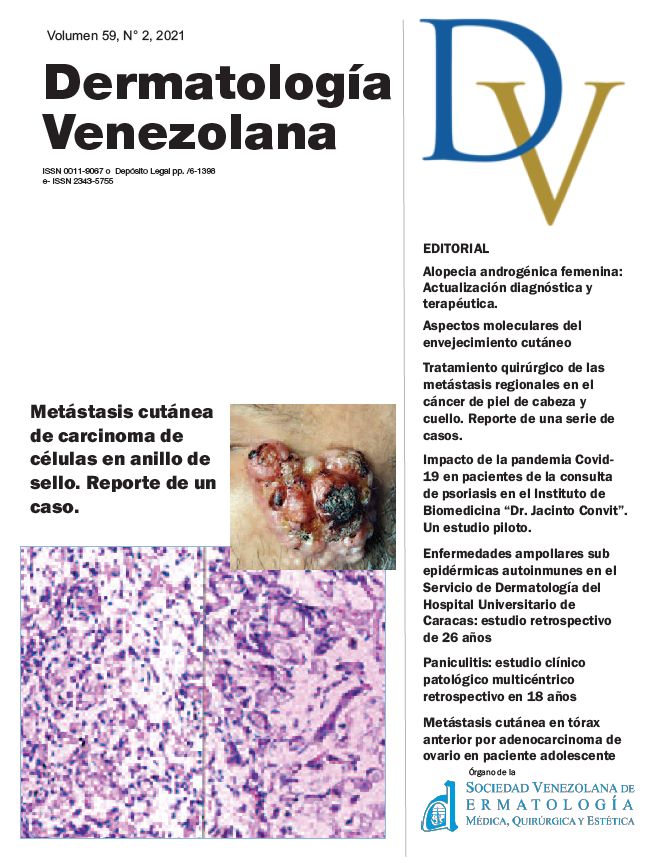Alopecia androgénica femenina: Actualización diagnóstica y terapéutica
Palabras clave:
alopecia androgénica femenina, pérdida de pelo, andrógenos, diagnóstico, tratamientoResumen
La alopecia inducida por andrógenos en individuos genéticamente predispuestos se denomina alopecia androgénica. La alopecia androgénica femenina (AAF) es un tipo de alopecia no cicatricial. La incidencia de AAF tiende a aumentar con la edad. Se ha reconocido que la alopecia androgénica tiene efectos psicológicos significativos en los pacientes. Para las mujeres afectadas la incapacidad para peinarse, insatisfacción con su apariencia y ansiedad por la continua pérdida de pelo, son las principales razones de preocupación. En la actualidad se han realizado varios estudios en cuanto al diagnóstico de la enfermedad, siendo la tricoscopia una herramienta útil de diagnóstico para la alopecia androgénica. Se ha evidenciado mejoría clínica con múltiples tratamientos sobre los que se hará énfasis en esta revisión.
Referencias
Tawfik SS, Sorour OA, Alariny AF, et al. White and yellow dots as new trichoscopic signs of severe female androgenetic alopecia in dark skin phototypes. International Journal of Dermatology. 2018; 57:1221-1228.
Salman KE, Altunay IK, Kucukunal NA, et al. Frequency, severity and related factors of androgenetic alopecia in dermatology outpatient clinic: hospital-based cross-sectional study in Turkey. An Bras Dermatol. 2017; 92:35-40.
Mysore V, Parthasaradhi A, Kharkar R, et al. Expert consensus on the management of androgenetic alopecia in India. Int J Trichol 2019; 11:101-106.
Guerra A, González-Guerra E, Borrás J. Alopecia androgénica femenina: nuevos factores fisiopatológicos y futuras tendencias para un abordaje clínico más integral. Más Dermatol. 2016; 26:25-36.
Atanaskova Mesinkovska N., Bergfeld W.F. Hair: What is new in diagnosis and management? Female pattern hair loss update: diagnosis and treatment. Dermatol Clin. 2013; 31:119–127
Ramos PM, Miot HA. Female Pattern Hair Loss: a clinical and pathophysiological review. Anais Brasileiros de Dermatologia. 2015; 90:529-543.
Brough K, Torgerson R. Hormonal therapy in female pattern hair loss. Int J Womens Dermatol. 2017;3: 53–57.
Guzmán-Sánchez D. Alopecia androgénica. Dermatol Rev Mex 2015; 59:387-394.
Ho B, Pei E, Chu C, et al. Microbiome in the hair follicle of androgenetic alopecia patients. PLoS ONE. 2019; 14:1-17.
Starace M, Orlando G, Alessandrini A. et al. Female Androgenetic Alopecia: An Update on Diagnosis and Management. Am J Clin. Dermatol. 2019; 21: 69–84.
Carmina E, Azziz R, Bergfeld W, et al. Female Pattern Hair Loss and Androgen Excess: A Report From the Multidisciplinary Androgen Excess and PCOS Committee. J Clin Endocrinol Metab. 2019; 104:2875-2891.
Ludwig E: Classification of the types of androgenetic alopecia (common baldness) ocurring in the female sex. Br J Dermatol. 1977; 97:247-254
Harries M, Tosti A, Bergfeld EN, et al. Towards a consensus on how to diagnose and quantify female pattern hair loss: the "Severity Index of female pattern hair loss (FPHL-SI) ". J Eur Acad Dermatol Venereol. 2016; 30: 667–676.
Olsen EA. The midline part: an important physical clue to the clinical diagnosis of androgenetic alopecia in women. J Am Acad Dermatol. 1999; 40:106-9.
Herskovitz I, Tosti A. “Female pattern hair loss.” Int J Endocrinol Metab. 2013; 11: 9860-68.
Yip Y, Sinclair RD. Antiandrogen therapy for androgenetic alopecia. Expert Rev Dermatol. 2006; 1:261–269.
Guzmán-Sánchez DA. Alopecia androgénica. Dermatol Rev Mex. 2015; 59:387-394.
Guerra-Tapia A, González-Guerra E. Alopecia de Patrón Femenino. Rev. Chilena Dermatol. 2009; 25:324-332.
Kibar M, Aktan S, Bilgin M. Scalp dermatoscopic findings in androgenetic alopecia and their relations with disease severity. Ann Dermatol. 2014; 26:478-484.
Rakowska A, Slowinska M, Kowalska-Oledzka E, et al. Dermoscopy in female androgenic alopecia: Method standardization and diagnostic criteria. Int J Trichol. 2009; 1:123-30
Vañó S, Saceda D. Alopecia androgénica. En Vañó S, Jaén P, directores. Manual práctico de tricología #TricoHRC. 1era edición. Madrid: Cuquerella medical commnications; 2020. P 24-65.
Faghihi G, Mozafarpoor S, Asilian A, et al. The effectiveness of adding low-level light therapy to minoxidil 5% solution in the treatment of patients with androgenetic alopecia. Indian J Dermatol Venereol Leprol. 2018; 84:547-553.
Rossi A, Campo D, Fortuna MC, et al. A preliminary study on topical cetirizine in the therapeutic management of androgenetic alopecia. J Dermatolog Treat. 2018; 29:149-151.
Chan L, Cook DK. Female pattern hair loss. Aust J Gen Pract. 2018; 47:459-464.
Sinclair RD. Female pattern hair loss: A pilot study investigating combination therapy with low-dose oral minoxidil and spironolactone. Int J Dermatol 2018; 57:104–09.
Jimenez-Cauhe J, Saceda-Corralo D, Rodrigues-Barata R, et al. Safety of low-dose oral minoxidil treatment for hair loss. A systematic review and pooled-analysis of individual patient data. Dermatol Ther. 2020; 33:14106-14114.
Lee SW, Juhasz M, Mobasher P, et al. A Systematic Review of Topical Finasteride in the Treatment of Androgenetic Alopecia in Men and Women. J Drugs Dermatol. 2018;17: 457-463.
Fernández‐Nieto D, Saceda‐Corralo D, Rodríguez‐Barata R, et al. Oral bicalutamide for female pattern hair loss: a pilot study. Dermatologic Therapy.2019; 32: 39.
Ferial Ismail F, Meah N, Carvalho L, et al. Safety of oral bicalutamide in female pattern hair loss: A retrospective review of 316 patients. J Am Acad Dermatol 2020; 83: 1478-1479.
Alves R, Grimalt R. A Review of Platelet-Rich Plasma: History, Biology, Mechanism of Action, and Classification. Skin Appendage Disord. 2018; 4:18-24.
Butt G, Hussain I, Jawad Ahmed F et al. Efficacy of platelet‐rich plasma in androgenetic alopecia patients J Cosmet Dermatol. 2019; 18: 996-1001.
Starace M, Alessandrini A, D'Acunto C, Melandri D, Bruni F, Patrizi A, Piraccini BM. Platelet-rich plasma on female androgenetic alopecia: Tested on 10 patients. J Cosmet Dermatol. 2019; 18:59-64.
Gentile P, Garcovich S. Autologous activated platelet-rich plasma (AA-PRP) and non-activated (A-PRP) in hair growth: a retrospective, blinded, randomized evaluation i
n androgenetic alopecia. Expert Opin Biol Ther. 2020; 20:327-337.
Abdallah MA, El-Zawahry KA, Besar H. Mesotherapy using dutasteride containing solution in male pattern hair loss: Acon trolled pilot study.J Pan Arab Leag Dermatol.2009;20:137.
Moftah N, Moftah N, Abd Elaziz G, et al. Mesotherapy using dutasteride containing preparation in treatmento female pattern hair loss: Photographic,morphometric and ultrastructural evaluation. J Eur Acad Dermatol Venereol.2013;27:686.
Reguero L, Durán-Vian C y Quintana-Sancho A. FR-Mesoterapia con dutasterida, una futura alternativa para el tratamiento de la alopecia androgénica Actas Dermosifiliog. 2020; 111: 419-420.
Saceda-Corralo D, Rodrigues-Barata AR, Vañó-Galván S, Jaén-Olasolo P. Mesotherapy with Dutasteride in the Treatment of Androgenetic Alopecia. Int J Trichology. 2017; 9:143-145
Starace M, Alessandrini A, Brandi N, Piraccini BM. Preliminary results of the use of scalp microneedling in different types of alopecia. J Cosmet Dermatol. 2020; 19:646-650.
Descargas
Archivos adicionales
- Alopecia androgénica femenina: Actualización diagnóstica y terapéutica
- Escala de densidad del pelo en la línea media de Ludwig
- Patrón de árbol de Navidad en alopecia androgénica
- Patrón de Hamilton en la alopecia androgénica femenina
- Escala de Sinclair para la pérdida de pelo de patrón femenino
- Fotos dermatoscopicas
- Criterios dermatoscópicos en alopecia androgénica femenina
- Carta compromiso autores
Publicado
Número
Sección
Licencia
Publicado por la Sociedad Venezolana de Dermatología Médica, Quirúrgica y Estética







